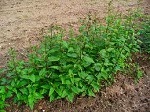 Botanical: Scrophularia nodosa
Botanical: Scrophularia nodosa
Family: N.O. Scrophulariaceae
Synonyms—Throatwort. Carpenter’s Square. Kernelwort., figwort.
(Welsh) Deilen Ddu.
(Irish) Rose Noble.
The Knotted Figwort, common throughout England, is similar in general habit to the Water Figwort, but differs both in the form of its root and in having more acutely heartshaped leaves. The stem, too, is without the projections or wings at its angles, and the lobes of the calyx have only a very narrow membraneous margin. The plant, also, though found in rather moist, bushy places, either in cultivated or waste ground, and in damp woods, is not distinctly an aquatic, like the Water Figwort.
The flowers, which resemble in appearance and character the Water Figwort, are in bloom during July and are specially visited by wasps.
During the thirteen months’ siege of Rochelle by the army of Richelieu in 1628, the tuberous roots of this Figwort yielded support to the garrison for a considerable period, from which circumstance the French still call it Herbe du siège. The taste and smell of the tubers are unpleasant, and they would never be resorted to for food except in times of famine.
Medicinal Action and Uses—It has been called the Scrofula Plant, on account of its value in all cutaneous eruptions, abscesses, wounds, etc., the name of the genus being derived from that of the disease for which it was formerly considered a specific.
It has diuretic and anodyne properties.
The whole herb is used, collected in June and July and dried. A decoction is made of it for external use and the fresh leaves are also made into an ointment.
Of the different kinds of Figwort used, this species is most employed, principally as a fomentation for sprains, swellings, inflammations, wounds and diseased parts, especially in scrofulous sores and gangrene.
The leaves simply bruised are employed by the peasantry in some districts as an application to burns and swellings.
The Welsh so highly esteem the plant that they call it Deilen Ddu (‘good leaf’). In Ireland, it is known as Rose Noble and as Kernelwort. Gerard tells us, referring to what he evidently considered an exaggerated estimate of its worth: ‘Divers do rashly teach that if it be hanged about the necke or else carried about one, it keepeth a man in health.’
The herb was said to be curative of hydrophobia, by taking
‘every morning while fasting a slice of bread and butter on which the powdered knots of the roots had been spread and eating it up with two tumblers of fresh spring water. Then let the patient be well clad in woollen garments and made to take a long, fast walk until in a profuse perspiration, the treatment being continued for seven days.’
A decoction of the herb has been successfully used as a cure for the scab in swine. Cattle, as a rule, will refuse to eat the leaves, as they are bitter, acrid and nauseating, producing purging and vomiting if chewed.
Preparation and Dosage—Fluid extract, 1/2 to 1 drachm.
A powerful medicine whenever Enlarged glands are present. Hodgkin’s disease.
A valuable skin remedy. Has a specific affinity for the breast; very useful in the dissipation of breast tumors. Eczema of the ear. Pruritus vaginae. Lupoid ulceration. Scrofulous swellings ( Cistus.) Painful hemorrhoids. Tubercular testis. Epithelioma. Nodosities in the breasts ( Scirrhinum.) Pain in all flexor muscles.
GUIDING SYMPTOMS
• Powerful remedy whenever ENLARGED GLANDS are present. Hodgkin’s Disease.
• Weakness, wants to lie down. Too weak to speak.
• Excessive drowsiness in the forenoon and afternoon, before and after eating.
• Head-Vertigo felt in vertex greater when standing.
• Dizziness, fullness and pressure in vertex.
• Pain from forehead to back of head.
• Severe lancinating pains refusing periodically.
• Eyes-Severe cutting pain, unable to move them with profuse sweat.
• Soreness of eyeballs.
• Black spots before eyes.
• On closing eye, visions of objects.
• Ears-Ringing in ears and sudden loss of hearing.
• ECZEMA AROUND EARS.
• Deafness before and after menses improving during flow.
• Abdomen-Pain in Right hypochondrium
• Colic just below navel and gripping in sides.
• Dull heavy, periodic pain
• Rectum-Painful, bleeding, protruding PILES.
• Female-Pruritus vaginae.
• Recurrent metritis with painful piles.
• Chest-Violent dyspnoea, oppression of chest with trembling.
• Pain about bifurcation of trachea.
• Constricted feeling in chest, cramp like pain transversely across lower chest < weeping.
• Asthma in scrofulous pts.
• Tumours and nodosities in the breast.
• Skin-Sallow skin.
• Burning of surface when rubbed.
• Hair falling.
• Prickling, itching all over back of hand, between fingers.
• Irritating vesicles on inside of lips.

Dr Sunitha Devi Vannemreddy, M.D(Hom), consult the doctor at drsunithavannemreddy@gmail.com
Subscribe
0 Comments